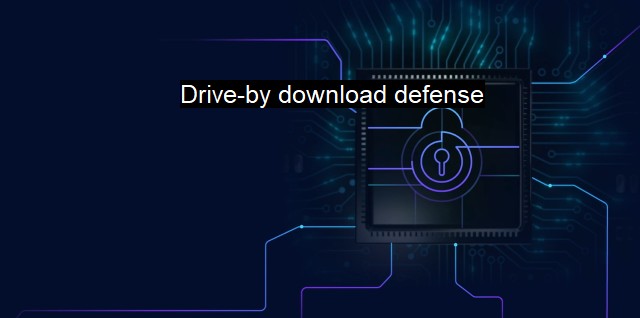What is Drive-by download defense?
Drive-By Downloads: Understanding the Crucial Concept of Drive-By Download Defense in Cybersecurity and Antivirus
A "drive-by download defense" refers to strategies employed to prevent drive-by download attacks, a common cybersecurity threat where unauthorized downloads happen on a user’s computer without their knowledge. Attacks of this nature often occur when visiting a website, viewing an email message, or simply clicking on a deceptive pop-up window, posing significant risks to users, as the downloaded content could include malware such as viruses, Trojans, or spyware.These threats are not minor; they can provide attackers access to confidential data, use the victim's computing power for cryptocurrency mining, or even transform the compromised device into a bot within a broader botnet. For businesses, this could mean substantial financial losses and a damaged reputation due to data breaches. As such, implementing a drive-by download defense is vitally important for safeguarding both individual and organizational cybersecurity.
The manifestation of drive-by download attacks varies. Generally, attackers exploit weaknesses in different web browsers or applications such as outdated browser plugins. Using website vulnerabilities or malvertising, attackers seamlessly redirect the user to a malicious site that houses the exploitative code. Once unloaded onto the user's device, the malicious script identifies the device's vulnerabilities and exploits them to download malware.
Given the intricacy of these attacks, implementing a sophisticated defense against drive-by downloads is paramount. Many use a multi-layered approach including both preventive and mitigative measures. Preventive measures aim to stop the malware from reaching the user’s device, while mitigative measures look to reduce the damage in case of a successful attack.
One principal preventive measure is maintaining browser and software updates. Since many drive-by download attacks capitalize on known vulnerabilities in outdated software, keeping everything up-to-date minimizes potential threats, as software updates often come with patches for known vulnerabilities. Many software providers release frequent updates to protect their users from emerging threats. Therefore, ignoring an update notification is akin to opening the gate for a possible attack.
Smart browsing is another preventive measure that goes a long way in protecting users. Often, drive-by downloads occur when users visit infected websites or click on malicious ads. Ensuring websites are secured (often denoted by an "https" prefix), being wary of pop-up ads, and refraining from visiting untrusted sites makes it harder for such attacks to succeed.
Firewalls and antivirus software play a crucial role in the drive-by download defense. They frequently scan a computer for known threats and irregular activities while also acting as a first line of defense against incoming attacks.
Beyond these measures, organizations can also use additional tools and settings that offer a degree of control over what downloads automatically. Stand-alone tools that assess websites for malice, software that blocks pop-ups, and privacy settings that prevent cookie tracking all add an extra layer of drive-by download defense.
Deploying Intrusion Prevention Systems (IPS) can help deter drive-by download threats on a network level. These systems actively monitor network traffic and shut down potentially dangerous connections.
Evidently, drive-by downloads are a potent threat considering they can happen unbeknownst to the user. by adopting a combination of best practices such as updating software, practicing smart browsing, utilizing firewalls and antivirus programs, leveraging additional tools to prevent unsolicited downloads, and for organizations, deploying intrusion prevention systems, one can establish a formidable drive-by download defense. Awareness and education also play an essential role in promoting these practices to ensure everyone plays their part holistically in defending against drive-by download attacks.

Drive-by download defense FAQs
What is a drive-by download?
A drive-by download is a type of cyberattack where malware is downloaded onto a computer or device without the user's knowledge or consent. This can happen when a user visits a malicious website or clicks on a link in a phishing email.How can I defend against drive-by downloads?
To defend against drive-by downloads, you should use antivirus and antimalware software to detect and block malicious downloads. You should also keep your operating system and software up to date with the latest security patches, and be cautious when clicking on links or downloading files from unknown sources.What is drive-by download defense?
Drive-by download defense is a set of techniques and tools used to prevent drive-by downloads from infecting a computer or device. This includes using antivirus and antimalware software, keeping software up to date, and being cautious when clicking on links or downloading files.What are some common signs of a drive-by download infection?
Common signs of a drive-by download infection include slow computer performance, frequent pop-up ads, changes to your homepage or search engine, and the appearance of unfamiliar programs or toolbars on your device. If you suspect your device has been infected with malware, you should run a full scan with your antivirus software and take action to remove any threats that are detected.| | A | | | B | | | C | | | D | | | E | | | F | | | G | | | H | | | I | | | J | | | K | | | L | | | M | |
| | N | | | O | | | P | | | Q | | | R | | | S | | | T | | | U | | | V | | | W | | | X | | | Y | | | Z | |
| | 1 | | | 2 | | | 3 | | | 4 | | | 7 | | | 8 | | |||||||